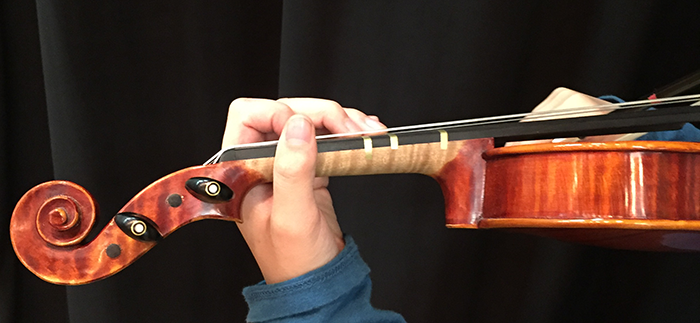
I have taught instrumental music for 38 years – covering ages 4 to adult – but middle school has always been a part of my teaching assignment. One technique that has proven very beneficial for me has been to embellish our lessons with a little humor and silliness. Here are a few additional ideas I hope will help streamline your string teaching day.
Beginner Instruments
In the Lincoln Public Schools we start string students in 4th grade. Any fourth grader who expresses an interest is allowed to start at no charge. If a student qualifies for “free or reduced lunch” every effort is made to help them get a district instrument – otherwise we are fortunate to have a number of quality music stores in town that stock quality instruments. We struggle like any other district with parents who purchase instruments “online” – usually of considerably lower quality. Whenever possible I encourage parents to work with nearby brick–and–mortar stores where instruments can be easily returned (when necessary) as well as serviced.
I recommend that all instruments have fingerboard tapes on them. After many years of trial and error I have found that ⅛” car pin stripe tape (seen in the photo above) works really well – you can get it from most any car parts store and it comes in a variety of cool colors. Most all other types and varieties of tape will eventually turn gooey and sticky. Need to remove some sticky goo? Goo Gone works wonders at cleaning off old tape residue.
Tuning
I still prefer to tune each instrument myself at the beginning of each lesson – not that I am a glutton for punishment – but rather because it gives me a quick opportunity to inspect each instrument. I set my digital tuner to an A then I quickly check the pitch of each string – while also checking the bridge angle and making sure the strings are centered on the fingerboard. Bridges can get easily bumped out of place which affects the tuning. It also gives me a chance to check the strings themselves for wear spots.
By the way, one of my favorite sayings is: “Ya know, you can tune a violin – but you can’t tuna fish!” It takes a little while for the students to get it but when they do it always brings a smile to their faces.
Posture Secret Code: “CBBF”
Very early on in the process we establish a secret code for our posture: “CBBF” – I write it on the board and we talk in a very soft voice – like we really have a secret going. I ask them what they think it means – you might be amazed at the answers they come up with (but then maybe not if you have been at this awhile). Then I reveal the secret code: “Chair Back, Buns Forward” – they quickly understand that when they sit they must sit on the very front edge of the chair. After that I simply remind them: “CBBF”.
For me, when starting a group of students – I like to start in a seated position with students holding their instruments in “guitar position” – that is holding the violin as if it were a guitar. This guitar position allows students to see if their fingers are curved and hitting the tape locations exactly. They start strumming the strings with their thumb.
Learning String Names
To help us learn the names of the open strings, we start with the “Ant Song” Chant. (Rhythm is 3 quarter notes plus 4 – 16th notes – in every line)
(E string) Eek! Eek! Eak! Look at all the
(A string) Ants, Ants, Ants, dig–ging in the
(D string) Dirt, Dirt, Dirt, crawling on the
(G string) Ground, Ground, Ground, all the way to
(C string) China, China, China (added for violas & cellos)
Violin students strum each of the open strings from highest to lowest – 4 times. You can have students solo on this while the rest of the group chants. For a real challenge – do it backwards.
The Open D String 12-Bar Blues
Another fun way to reinforce the names of the open strings is the blues. Students can play the open string blues in guitar position, in chin position or with the bow.
D D D D
G G D D
A G D D*
Students are asked to play 4 notes for each note listed. So they do the math and discover they need to play 16 – open D’s in the first line – I try to quickly get them to group in their mind 4 groups of 4 notes (4 quarter notes in 4 measures). The exception will be the very last D (with the asterisk) here they play only a single note and then lift their bow and reset to play it again.
If you have piano skills you can play some sort of blues groove behind their playing. I happen to be piano-challenged, so I use a track from the SmartMusic Jazz Improvisation library called the P.T. Shuffle – a very simple blues track that I can slow way down and repeat until we get the hang of things. All string instruments can play the D Blues – you can then transpose the blues track in SmartMusic for the blues in A – using the E string, or G Blues featuring cello, viola C strings.
The Blues can be played in standing position starting at a slow tempo – concentrating on proper bow posture – with the left hand just gabbing the upper bout with the thumb on the thumb button (bass of the neck). When we play the blues with the bow – it becomes the “Bow Blues.”
I use the accompaniment tracks regularly – the tracks reinforce at least three important musical concepts every time we use them:
- Playing with a nice steady tempo – even with a group.
- Give us a tonal pitch center to start working to match or emulate.
- A Time Signature – students quickly learn that the top number of the time signature will tell them the number of prep clicks beats they hear before they are to start playing.
In addition, we can start slowly but can easily increase the tempo as we gain confidence and as our skills allow.
Closing Thoughts
One of my favorite quotes from one of my 4th grade violinists is: “Wow! This is way easier when you put a little groove to it!”
When one group is getting ready to leave as the next group is coming in – my saying is: “OK, act like a tree and leave!”
Happy Stringing!
 Jim Schulz has 40 years of experience in teaching all levels of instrumental music, including band, jazz band, and orchestra. He currently enjoys working with 4th-6th grade students in the Lincoln Public Schools in Lincoln, NE. He received his B.M.E and M.M. degrees from University of Nebraska –Lincoln, and has participated in International Music Workshops in Lausanne, Switzerland and Graz, Austria. Mr. Schulz is a past president of NSBA and ASTA, has held positions of chair of orchestra affairs and middle level chair with NMEA and middle level chair for NSBA.
Jim Schulz has 40 years of experience in teaching all levels of instrumental music, including band, jazz band, and orchestra. He currently enjoys working with 4th-6th grade students in the Lincoln Public Schools in Lincoln, NE. He received his B.M.E and M.M. degrees from University of Nebraska –Lincoln, and has participated in International Music Workshops in Lausanne, Switzerland and Graz, Austria. Mr. Schulz is a past president of NSBA and ASTA, has held positions of chair of orchestra affairs and middle level chair with NMEA and middle level chair for NSBA.
Jim is also an active musician, clinician, and adjudicator in Nebraska and Iowa.